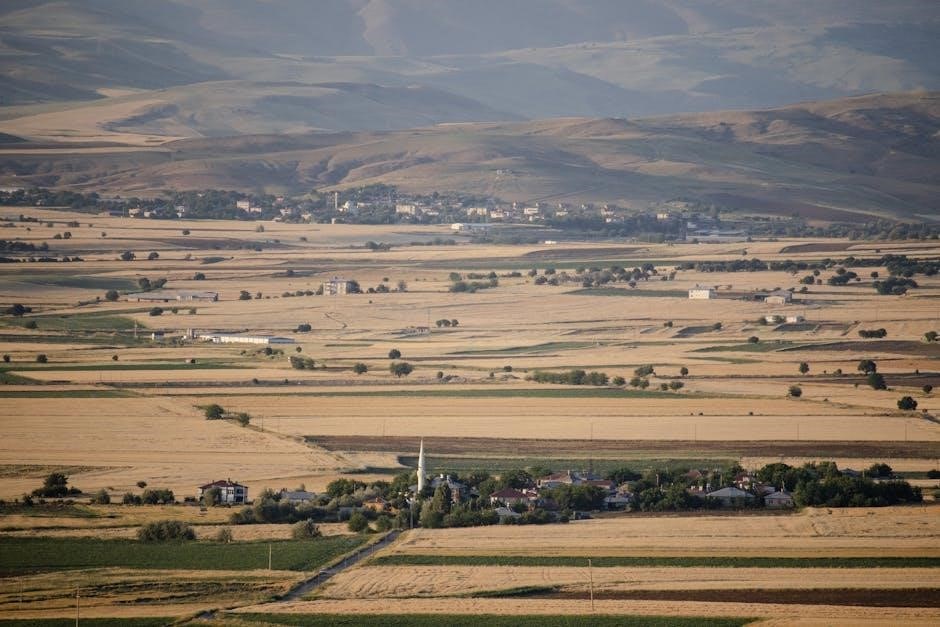The Village of Hommlet, a classic AD&D module by Gary Gygax, is set in a woodland crossroads. It became central to the struggle against the Temple of Elemental Evil, offering a mix of exploration, role-playing, and combat. The PDF version provides a detailed guide, including maps and key locations, making it a timeless starting point for adventurers and a precursor to larger quests.
1;1 Overview of the Village and Its Significance
The Village of Hommlet, nestled in a woodland crossroads, has evolved into a crucial setting in fantasy role-playing. Once a quiet settlement, it became entangled in the conflict with the Temple of Elemental Evil, a nearby source of darkness. The village’s significance lies in its resilience and recovery after the temple’s destruction, offering a blend of rural charm and adventure opportunities. Its detailed layout, vibrant NPCs, and strategic location make it a compelling starting point for adventurers and a cornerstone of the campaign.
1.2 Historical Context and Background
Created by Gary Gygax in 1979, the Village of Hommlet was originally part of the Temple of Elemental Evil module. Its history is marked by the rise and fall of the nearby temple, which brought chaos and destruction. The village’s recovery after the temple’s destruction a decade ago has allowed it to thrive, though remnants of evil still linger. The PDF version captures this rich history, detailing the village’s transformation and its role in the broader campaign setting, making it a foundational element for adventurers and storytellers alike.
The Village of Hommlet as a Campaign Setting
The Village of Hommlet serves as a versatile campaign setting, blending exploration, role-playing, and combat. Its quaint atmosphere and rich history provide endless opportunities for immersive storytelling and strategic challenges, supported by detailed maps and key locations in the PDF, making it an ideal starting point for both new and seasoned adventurers.
2.1 Key Locations Within the Village
The Village of Hommlet features several key locations that enhance its charm and gameplay potential. The crossroads at its center connect travelers from all directions, while the local inn provides rest and gossip. The church stands as a beacon of hope, offering divine aid, and the trading post supplies adventurers with essential gear. The guard tower ensures safety, and the nearby Moathouse looms with mystery. These locations create a vibrant setting for interaction, exploration, and adventure, making Hommlet a dynamic hub for players.
2.2 Notable NPCs and Their Roles
The Village of Hommlet is populated by a variety of memorable NPCs who shape the story and gameplay. The innkeeper offers refuge and rumors, while the village priest provides divine guidance. A cunning trader supplies adventurers with gear, and the captain of the guard ensures order. These characters create a lively atmosphere, each with unique personalities and agendas, adding depth to the village’s social dynamics and offering players opportunities for interaction and quest hooks that drive the adventure forward.
2.3 The Village as a Starting Point for Adventures
The Village of Hommlet serves as an ideal starting point for low-level adventurers, offering a rich setting for exploration and role-playing. Its woodland location and proximity to the Temple of Elemental Evil create a natural progression for quests. Players can engage with the village’s social dynamics, uncover local mysteries, and prepare for larger challenges. This setup allows for a gradual introduction to the game’s mechanics and story, making it a perfect foundation for both new players and experienced adventurers seeking a classic D&D experience.

The Temple of Elemental Evil
The Temple of Elemental Evil, a grand edifice of wickedness, arose near Hommlet, embroiling the village in a struggle between gods and demons. Its destruction a decade ago brought relief, but remnants of evil persist. The PDF details its rise, impact, and downfall, serving as a sequel to Hommlet’s story and a cornerstone of D&D history.
3.1 The Rise of the Temple and Its Impact
The Temple of Elemental Evil emerged as a dark force near Hommlet, transforming a small, secluded structure into a hub of malevolence. Its influence spread rapidly, corrupting the surrounding lands and drawing evil creatures. The temple’s power disrupted trade and peace in Hommlet, fostering fear and instability. Dark priests and their followers sought to dominate the region, plunging it into chaos. The temple’s rise marked the beginning of a dire struggle, with Hommlet caught in the shadow of its evil presence, as detailed in the PDF guide.
3.2 The Relationship Between Hommlet and the Temple
Hommlet’s proximity to the Temple of Elemental Evil forged a complex bond, marked by conflict and resilience. The temple’s evil influence disrupted the village’s tranquility, drawing it into a divine struggle. Despite the temple’s destruction a decade ago, Hommlet still grapples with remnants of darkness, as detailed in the PDF. The village serves as a testament to the enduring impact of the temple’s malevolence and the courage of its inhabitants in the face of overwhelming evil, shaping its identity and history.
3.3 The Destruction of the Temple and Its Aftermath
The Temple of Elemental Evil was destroyed a decade ago, its evil influence nullified by powerful blessings and magic. Hommlet returned to a semblance of its former life, yet the village still contends with bandits and strange monsters. The PDF details this challenging period, showcasing the aftermath of the temple’s destruction and its lasting impact on Hommlet, as the village rebuilds and faces new threats in its quest for peace and prosperity.
Gameplay and Adventure Elements
The Village of Hommlet PDF offers rich exploration, strategic combat, and deep role-playing opportunities. Players uncover hidden secrets, battle foes, and engage with memorable NPCs, enhancing the adventure experience.
4.1 Exploration Opportunities in Hommlet
The Village of Hommlet PDF provides a detailed setting for exploration, with its woodland crossroads, bustling inn, and mysterious church. Players can uncover secrets in the nearby ruins, interact with intriguing NPCs like Lareth, and venture into the surrounding wilderness. The module’s layout and maps encourage immersive discovery, making Hommlet a compelling starting point for adventurers. Its connection to the larger Temple of Elemental Evil adds depth, inviting players to explore beyond the village.
4.2 Combat and Strategic Challenges
Hommlet offers diverse combat opportunities, from fending off bandits to battling strange monsters. The PDF details encounters, enemy strengths, and tactical scenarios. Players must strategically plan battles, utilize resources, and adapt to challenges. The module’s design balances combat with exploration, ensuring engaging fights that test both strength and wits; These challenges prepare adventurers for larger threats, like the nearby Temple of Elemental Evil, making Hommlet a dynamic setting for both combat and strategy.
4.3 Role-Playing and Storytelling Potential
Hommlet excels as a setting for rich role-playing and storytelling. The PDF details numerous NPCs, each with unique personalities and motivations, offering ample opportunities for engaging interactions. The village’s history, its struggle against the Temple of Elemental Evil, and its current state provide a compelling backdrop for narratives. Players can uncover secrets, forge alliances, and shape the village’s future, making Hommlet a vibrant canvas for immersive storytelling and character development.

The PDF Version of the Village of Hommlet
The Village of Hommlet PDF offers a detailed guide, including maps, NPCs, and adventure hooks. It serves as a comprehensive resource for both players and DMs, enhancing gameplay.
5.1 Availability and Formats
The Village of Hommlet PDF is widely available for download from various online platforms, including official D&D archives and third-party marketplaces. It is offered in standard PDF format, ensuring compatibility with most digital readers. Additionally, some versions include high-resolution maps and supplementary materials, making it a versatile resource for both virtual and tabletop gaming experiences. Its digital format allows easy access and reference during gameplay, enhancing convenience for both players and Dungeon Masters.
5.2 Features of the PDF Edition
The Village of Hommlet PDF includes detailed maps of the village, its key locations, and surrounding areas. It features original artwork and a searchable format for easy navigation. The document provides a comprehensive overview of the village layout, notable NPCs, and historical context. Additional resources, such as adventure hooks and encounter descriptions, enhance gameplay. The PDF edition is compatible with modern digital platforms, making it a convenient and essential tool for both players and Dungeon Masters seeking to explore this iconic setting.
5.3 Benefits of Using the PDF for Gaming
The Village of Hommlet PDF offers enhanced accessibility and convenience for gamers. Its digital format allows for easy reference during sessions, with quick searches and zoomable maps. Players and DMs can access it on multiple devices, making preparation and gameplay seamless. The PDF preserves the original content while adding modern readability, ensuring a smooth transition from physical to digital. This format also reduces clutter and provides a durable, long-lasting resource for campaigns, enhancing the overall gaming experience with minimal effort.

The Sequel and Expansion Modules
The sequel to Hommlet, initially planned as T2, was released as T1-4 Temple of Elemental Evil. Other expansions include Hackmaster adaptations and a 4e conversion in 2009.
6.1 T1-4 Temple of Elemental Evil
T1-4 Temple of Elemental Evil combines the original Village of Hommlet module with its sequels, offering a comprehensive adventure. Originally planned as separate modules (T1-T4), delays led to their compilation into a single supermodule. The PDF version includes the classic T1 and updated content for modern play. This iconic adventure transitions players from Hommlet to the Temple, providing a seamless narrative and expansive gameplay opportunities.
6.2 The Delayed Release of T2 and Its Impact
The release of T2, the sequel to T1 Village of Hommlet, was significantly delayed. This disruption led to the eventual compilation of T1-T4 into a single supermodule, Temple of Elemental Evil. The delay caused the adventure to feel disjointed, with some parts underdeveloped. Players and DMs faced challenges due to poor organization and repetitive encounters, necessitating extensive preparation and additional resources to enhance gameplay and storytelling within the module.
6.3 Other Related Modules and Adventures
Beyond T1-4, the Village of Hommlet is linked to various modules and adaptations, including video games like the 2003 Atari release and Hackmaster’s reinterpretation. Additional content like Return to the Moathouse and 4e conversions expand gameplay. Fan-made materials, such as maps and actual play reports, enrich the experience. These resources provide depth, making Hommlet a versatile setting for both classic and modern D&D editions, offering endless opportunities for exploration and storytelling.
Video Game Adaptations
The Village of Hommlet was adapted into a video game by Atari in 2003, and Hackmaster released its version in the same year. These games capture the essence of Hommlet and its connection to the Temple of Elemental Evil, offering players a digital exploration of this iconic D&D setting.
7.1 The 2003 Atari Video Game Adaptation
The 2003 Atari video game adaptation brought the Village of Hommlet and the Temple of Elemental Evil to life digitally. Faithful to the original module, it featured exploration of Hommlet, interactions with its inhabitants, and battles against evil forces. Players could uncover the village’s secrets, engage in strategic combat, and delve into the temple’s depths. The game captured the essence of the D&D adventure, offering a mix of exploration, puzzle-solving, and RPG elements, making it a memorable adaptation for fans of the series.
7.2 Hackmaster and Other Third-Party Adaptations
Hackmaster adapted the Temple of Elemental Evil as “The Temple of Existential Evil” by Brian Jelke in 2003, offering a humorous twist. Other third-party creators have produced unique interpretations, expanding the Village of Hommlet’s lore. Fan-made modules, maps, and supplements enrich the setting, while communities share custom content. These adaptations showcase the enduring appeal of Hommlet, inspiring new adventures and creative reinterpretations that keep the legacy alive for modern gamers.

Community Resources and Supplements
Fans and creators offer extensive resources, including fan-made maps,Actual Play reports, and forums discussing Hommlet. Trent’s environmental tables and Paul’s regional maps enhance gameplay, while communities share insights and adaptations, fostering engagement and creativity among enthusiasts.
8.1 Fan-Made Content and Maps

Fan-made content for Hommlet includes detailed maps, such as Paul Stormbergs’ regional maps, and Trents’ environmental tables. These resources, available online, enhance gameplay by providing visual and narrative depth. Maps depict key locations like the village, temple, and surrounding areas, while tables offer encounters and descriptions. Fans also share custom adventures, art, and adaptations, enriching the Hommlet experience for players and DMs alike, ensuring its legacy endures.
8.2 Actual Play Reports and Reviews
Actual play reports and reviews of Hommlet offer insights into player experiences and DM strategies. Blogs like Golddiggers Adventures provide detailed accounts of adventures, while forums discuss module strengths and weaknesses. Reviews highlight key encounters and areas needing DM intervention, aiding both new and experienced players; These resources enrich the community, fostering a deeper understanding of Hommlet’s role in adventures and its connection to the Temple of Elemental Evil.
8.3 Forums and Discussions About Hommlet
Forums and online communities are vibrant with discussions about Hommlet, sharing resources like Trent’s environmental tables and Paul Stormbergs’ regional maps. Enthusiasts exchange tips on running the module, debating its strengths and weaknesses. Players and DMs collaborate on solving challenges, creating a rich tapestry of ideas. These discussions highlight the module’s adaptability and enduring appeal, fostering a sense of community among fans of Hommlet and the Temple of Elemental Evil.

Legacy and Influence
The Village of Hommlet, crafted by Gary Gygax, stands as a foundational D&D module, influencing countless modern adventures and leaving an indelible mark on tabletop gaming culture.
9.1 Hommlet’s Role in D&D History
As the first module in the Temple of Elemental Evil series, Hommlet became iconic in D&D history, setting a benchmark for low-level adventures. Its design influenced future modules, showcasing how a small village could serve as a gateway to epic quests, thus shaping the way campaigns are structured and executed in the world of Dungeons & Dragons.
9.2 Inspirations for Modern Adventures
The Village of Hommlet’s modular design and rich narrative have inspired modern D&D adventures. Its focus on a small, detailed setting serves as a blueprint for creating immersive starting points. The PDF version’s availability has allowed new generations of players and creators to draw inspiration, integrating Hommlet’s legacy into contemporary campaigns and homebrew content, ensuring its influence endures in the evolving world of Dungeons & Dragons.
9.3 Cultural Impact on Gaming Communities
The Village of Hommlet has left a lasting mark on gaming culture, inspiring countless fan creations, discussions, and adaptations. Its iconic setting and modular design have fostered a sense of community, with players and creators sharing resources, maps, and stories. The PDF version’s accessibility has further cemented its place in D&D history, making it a beloved and enduring piece of gaming heritage that continues to unite enthusiasts across generations.
Modern Re-Releases and Updates
The Village of Hommlet has been re-released in PDF format, including a 5th Edition conversion and updated content. OAR 6 offers a modernized version with classic modules.
10.1 5th Edition Conversion and Updates
The 5th Edition conversion of The Village of Hommlet, featured in OAR 6, seamlessly integrates classic content with modern D&D mechanics. This updated version includes revised encounters, balanced NPCs, and enhanced storytelling elements, ensuring compatibility with contemporary playstyles while preserving the module’s iconic charm. Players and DMs alike can now explore Hommlet and its environs with fresh dynamics, making it a vibrant addition to any 5th Edition campaign. The PDF edition offers crisp layouts and nostalgic artwork, blending tradition with innovation.
10.2 Reprints and Anniversary Editions
The Village of Hommlet has seen several reprints and anniversary editions, celebrating its enduring legacy. A 40th-anniversary edition was released, featuring updated content and commentary from Gary Gygax. The PDF format ensures accessibility, preserving the module’s classic feel while catering to modern players. These reprints often include remastered maps, nostalgic artwork, and additional designer notes, making them a must-have for collectors and fans of the original 1979 module. They honor the module’s history while introducing it to new generations of adventurers.
The Village of Hommlet in Popular Culture
The Village of Hommlet has inspired countless references in media, from books to video games, solidifying its place in gaming culture. Its iconic status endures.
11.1 References in Media and Literature
The Village of Hommlet has been referenced in various media, including literature and video games. Its iconic status as a campaign setting has inspired fan creations and adaptations. The module’s influence is evident in modern D&D adventures, with its themes and locations often appearing in popular culture. The PDF version has further cemented its place in gaming history, making it a beloved and enduring part of the D&D legacy.
11.2 Art and Fan Creations Inspired by Hommlet
The Village of Hommlet has sparked a vibrant community of artists and creators. Fans have produced stunning digital art, fan maps, and cosplay inspired by the village’s charm. The PDF version’s detailed maps and descriptions have further fueled creative projects, allowing enthusiasts to craft custom content. Additionally, the 2003 Atari video game adaptation and third-party interpretations like Hackmaster’s version have inspired fan art and literature. These creations reflect the enduring appeal of Hommlet’s setting and lore.

The Future of the Village of Hommlet
Upcoming adaptations and new projects promise to revive Hommlet’s legacy. Recent 5th Edition conversions and community-driven content ensure its continued relevance in modern D&D campaigns.
12.1 Upcoming Adaptations and Projects
Exciting new adaptations of Hommlet are on the horizon, with rumors of updated 5th Edition modules. Digital platforms are also expected to enhance the PDF version with interactive maps and expanded lore. Fan communities are creating custom content, ensuring Hommlet remains vibrant. These projects aim to introduce the village to new players while honoring its classic charm, blending tradition with modern gameplay innovations for a fresh experience.
12.2 Community Expectations and Hopes
The community eagerly anticipates new adaptations of the Village of Hommlet, hoping for enhanced PDF versions with interactive maps and expanded lore. Fans desire more detailed character backstories and open-world elements to enrich storytelling. They also expect faithful adaptations of the Temple of Elemental Evil legacy, blending classic charm with modern innovations. The goal is to preserve the module’s timeless appeal while making it accessible to new generations of players and Dungeon Masters alike.
